Malaviya National Institute of Technology, Jaipur
The Malaviya National Institute of Technology (MNIT) is a public technical university located in Jaipur, India with emphasis on science, engineering and management.
मालवीय राष्ट्रीय प्रौद्योगिकी संस्थान जयपुर | |
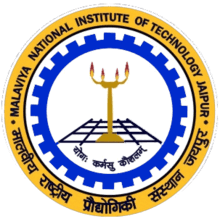 | |
Former name | Malaviya Regional Engineering College (MREC), Jaipur |
|---|---|
| Motto | य़ॊगः कऱमसु कौशलम |
Motto in English | Diligence leads to Excellence |
| Type | Public technical university |
| Established | 1963 |
| Dean | Prof. Heerank Chandra(Dean,Student Welfare) |
| Director | Udaykumar R Yaragatti |
| Address | Jawahar Lal Nehru Marg, Jhalana Gram, Malviya Nagar , , , 26.8622°N 75.8156°E |
| Campus | Urban, 317 acres (1.28 km2) |
| Acronym | MNIT |
| Colors | Red and White |
| Affiliations | Ministry of Human Resource Development |
| Website | www |
Formerly known as Malaviya Regional Engineering College (MREC) Jaipur, it assumed its present name in 2002 and was recognised as an Institute of National Importance in 2007. It was founded in 1963 with only 2 engineering branches and now comprises fourteen departments, a school of management and allied centres.[1][2][3] The Institute is fully funded by Ministry of Human Resource Development(MHRD), Government of India and is governed by a Senate as per NIT Statutes.[4][5]
History
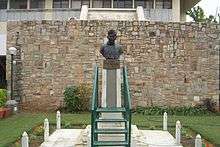
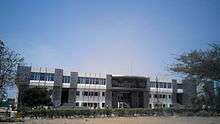
The institute was established in 1963 as Malaviya Regional Engineering College (MREC), as a joint venture of the government of India and Government of Rajasthan.[1] It was named after Madan Mohan Malaviya. V.G. Garde was its first principal. The institute originally functioned from a temporary campus at Pilani and admitted 30 students each in Electrical Engineering and Mechanical Engineering. The college moved to the present campus to Jaipur in 1965.
It used to offer five-year Bachelor of Engineering programmes in Civil, Electrical, Mechanical and Metallurgical Engineering. The duration of the B.E. Degree Course was changed to four years from 1983.
The institute was upgraded to a National Institute of Technology and was declared a Deemed University on 26 June 2002 and since then the institute started offering Bachelor of Technology (BTech) degree instead of Bachelor of Engineering (B.E.) degree.
On 15 August 2007, MNIT and all other NITs were declared Institutes of National Importance by the government of India under the National Institutes of Technology Act, 2007.[6] The institute is now under The Ministry of Human Resource and Development, New Delhi. It has been selected to participate in the Technical Education Quality Improvement Program of the government of India and the World Bank.[7]
MNIT celebrated its Golden Jubilee foundation year in 2013.[8]
Academics

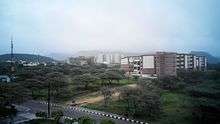
Programmes
MNIT offers a wide variety of courses of study in engineering, sciences, management, design and humanities with a primary focus on engineering. Eight four-year undergraduate courses of study leading to the Bachelor of Technology degree and a five-year undergraduate course leading to the Bachelor of Architecture degree, with a total of over 5000 students. Postgraduate degrees award Master of Technology (MTech), Master of Science (MSc), Master of Business Administration (M.B.A) and Master of Urban Planning. There are also doctoral programs with over 300 students. There are over 150 faculty members engaged in teaching and research.
Financial aid
More than 30 financial aid schemes are made available to students under different criteria to support institute fees and in some cases hostel accommodation as well.[9]
Requisites for enrolments
Admission to undergraduate courses of the institute is through the Central Seat Allocation Board (CSAB) which takes into account the performance in Joint Entrance Examination (JEE).[10]
Supernumerary seats are reserved for students from outside India who are nominated by the Ministry of External Affairs, Govt. of India, and the Indian Council of Cultural Relations and DASA students. SAT scores are criteria for selection.[11][12]
Admission for post graduate courses namely Master of Technology (MTech) and Master of Urban & Regional Planning (MURP) are through Centralized Counselling for MTech/MArch and M.Plan (CCMT) after Graduate Aptitude Test in Engineering (GATE).[13][14]
Admission to MSc is through CCMN (centralised counselling for MSc/MSc(Tech.), admission to M.B.A. is through GMAT/CAT followed by GD,PI and PhD is through department's respective written test followed by interview.
Rankings
| College rankings | |
|---|---|
| Engineering – India | |
| NIRF (2020)[15] | 35 |
Malaviya National Institute of Technology, Jaipur was ranked 35th among engineering colleges by the National Institutional Ranking Framework (NIRF) in 2020.[15]
Grading
MNIT follows the credit-based system of performance evaluation, with proportional weighting of courses based on their importance. The total marks (usually out of 100) form the basis of grades, with a grade value (out of 10) assigned to a range of marks. This range of marks is decided by Grade Moderation Committee and is relative in nature. For each semester, the students are graded by taking a weighted average from all the courses with their respective credit points. Each semester's evaluation is done independently with a cumulative grade point average (CGPA) reflecting the average performance across semesters.
Research
Research in the institute is sponsored by major government agencies which include the Indian Ordnance Factories, Ministry of Communication & IT, Govt. of India, Council of Scientific and Industrial Research (CSIR), Defence Research and Development Organisation (DRDO) and the Department of Science and Technology (DST).
Collaboration with International Universities
- University of Greenwich, London
- Stevens Institute of Technology
- North Dakota University
- University of Saskatchewan
- Deakin University
- Florida International University
- University of Dundee
- Medine Education, Mauritius
Administration
Organisational structure
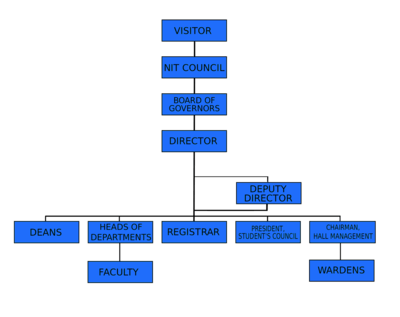
MNIT shares a common Visitor (a position held by the President of India) who is the most powerful person in the NIT organizational structure and the NIT Council with the other sister NITs.
The board of governors consists of members nominated by NIT Council, the director, representatives from Department of Higher Education, Ministry of Human Resource and Development, Government of India.
The institute's director, serves as the chief academic and executive officer of the institute. He is aided by the deputy director. Under the director and the deputy director are the deans, heads of departments, registrar, president of the students' council, and chairman of the hall management committee.
The registrar is the chief administrative officer and oversees day-to-day operations. He is the custodian of records, funds, and other properties of the institute.
Under the charge of the heads of departments (HODs) are the faculty (full-time professors as well as those of associate and assistant status). The wardens of hostels are placed under the chairman of the hall management committee in the organisation.
Financing
Annually, the institute receives US$20 million from the Government of India and World Bank.[17] Alumni and other bodies also donate to contribute to development in the institute. Financial management is undertaken by Financial Committee of the institute.[18]
Academic policies
The academic policies of the institute are decided by its senate. It consists of deans of the institute, all the professors, the director, educationists and specialists. The senate controls and approves the curriculum, courses, examinations and results and appoints committees to look into academic matters. The teaching, training and research activities of the institute are reviewed by the senate to maintain educational standards. The director serves as the ex-officio and chairman of the senate.
Motto
"Yogaḥ Karmasu Kauśalam" (योगः कर्मसु कौशलम् in Sanskrit). The motto literally translates to "Excellence in action is Yoga" essentially implying that doing your work well is (true) yoga or "Diligence leads to Excellence". It is sourced to Sri Krishna's discourse to Arjuna in Bhagavad Gita, chapter 2 verse 50. This quote in its larger context of Gita urges man to acquire equanimity because such a soul endowed with the mind of equanimity allows him to shed the effects of his good and evil deeds in this world itself. Equanimity is the source of perfection in Karmic endeavours while leading to Salvation.[19]
Departments, centres and schools

Engineering departments
- Architecture
- Chemical Engineering
- Civil Engineering
- Computer Science & Engineering
- Electrical Engineering
- Electronics and Communication Engineering
- Metallurgical Engineering and Materials Engineering
- Mechanical Engineering
- Indian Institute of Information Technology, Kota[20] (temporary campus) – Computer Science Engineering and Electronics & Communication Engineering
Centres
- Energy and Environment
- Earthquake and Disaster Mitigation Centre
- Innovation and Incubation Centre
- Advance Materials Research Centre
- Tribology Laboratory
- Electronics & ICT Academy
- Stones
Science departments
- Applied Biology
- Mathematics
- Physics (Photonics and Electronics )
- Chemistry
Allied departments
- Humanities and Social Sciences
- Department of Physical Education
Campus


MNIT's 317-acre campus is located in Jaipur, Rajasthan, approximately 2.5 miles (4 km) from Jaipur International Airport. It is 6 miles (10 km) from Pink City and is within walking distance from business district and therefore the two locations are frequent getaways for MNIT students. The vast campus is lush green and has a hill out of Aravali Ranges. Numerous buildings, clusters constitute the campus. To the west are the departmental buildings, research laboratories, associations and club buildings, lecture theatres, bank (ICICI Bank),[21] post office, canteens, lawns, auditoriums, main building, computer centre; to the east are Boys hostels, STP; to the north are guest houses, staff quarters, bank (SBI);[22] at the centre and south are sports facilities and dispensary.


The dispensary is supervised by a team of Medical Officers and supported staff. The institute has a part-time Homeopathic doctor and Ayurvedic doctor on the campus. Canteen buildings, five in all, are near the instructional zone and hostels and in addition to it, an Amul parlor. The central canteen is run by Akshaya Patra Foundation. There are two guest houses in the campus for visitors, alumni, guests and guardians of students.
Each Department has its own building which have laboratories, staff cabins, lecture halls, classrooms, auditoriums, departmental libraries, etc., and all are linked via a continuous gallery that runs throughout the eastern part.
Sports facilities
Facilities for sports and games include a soccer ground, a cricket ground with nets, three basketball courts, three lawn tennis courts, three volleyball courts and three raw volleyball courts, one indoor badminton court and other outdoor badminton courts, a gymnasium, a billiards room, a chess room, a jogging track, table tennis boards and a swimming pool is in future plans.
Materials Research Center
Materials Research Center (MRC) has infrastructure for advanced research in various streams with focus on materials. The facilities are extended to the scientists and researchers of other institutes. Equipment at the center, set up at the cost of $6.3 million, offers a wide range of research assistance.[23] Various machines, facilities and software available in the lab.[24][25]
Central Library
Now known as LEARNING RESOURCE CENTRE (LRC), aids the teaching and research programmes of the institute and provides facilities for general reading and information with 156,314 print books, 3073 ebooks, 10,000 e-journals, international journals, technical pamphlets, standards, CD-ROMs and periodicals. In addition, it is connected to other library networks like DELNET, which enables students to access libraries of other 4697 Indian and International libraries. It is spread across a plinth area of 15,847 Sq. feet. The services and operations in the library are fully digital with RFID and Smart card systems with Koha (software). In addition to books, it offers wifi and LAN services.[26][27][28]
Computer Center
The Centre has 10 computer laboratories. A Data centre with Private Cloud using VMWare V Cloud Suite 5 and 64 TB of EMC2 Storage has also been established in the centre. The Private Cloud has features of automated provisioning of IT resources, single interface for administrator for entire IT infrastructure and work load elasticity. It is used for Library digitisation, E-mail archival, hosting various services/applications and Research on cloud computing by PhD and MTech students.[29]
Vivekananda Lecture Theatre Complex
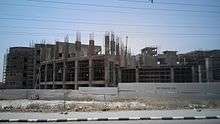
Vivekananda Lecture Hall complex will have 40 class rooms that could accommodate about 5,500 students at a time. It will have a food court in its basement. Its construction was started on 19 September 2012. It holds the record of being Asia's Largest Lecture Theatre Complex. [30]
Among other facilities, each hostel is equipped with Wi-fi and/or LAN, and a common room with a TV, LAN, table-tennis court, newspaper stands and a mess.
Student life

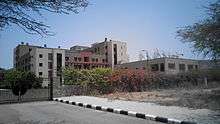
Annually MNIT conducts the MNIT Sports Tournament(MST). Students from all across Rajasthan and other parts of North India, participate in the event. MNIT also hosts inter-NIT sports tournaments being a part of the Inter-NIT sports federation. The institute is West zone centre for NBA JAM.[32]
National level events include Neuron, Blitzschlag, Electronica, Moments, MST, Schrifftum, Taal and Zodiac.[33]
Hostel
MNIT has 10 boys and 2 girls hostels with an accommodation capacity of about 3000 students. The largest among them is Aurobindo Hostel comprising 950 single bed rooms. First year students are allotted triple bed rooms and from second Year onwards everyone gets single bed rooms. Most of the hostels are equipped with mess. Students are given Wifi, LAN, common room and sports facilities in hostels.[34]
Blitzschlag
Blitzschlag is the annual cultural fest of MNIT Jaipur. It is a 3-day event held towards the start of February every year and attracts a crowd of over 5000 students from more than 20 colleges all over the country.[35]
The word Blitzschlag has German origins; it means a lighting strike. Aimed at inspiring innovation, technical interest among students and awareness among the public, the event has played host to lectures, seminars, workshops, competitions, exhibitions, and quizzes.
The event is organised by the students under the guidance of their teachers.
Sphinx
Sphinx is the annual tech-fest organized autonomously by Malaviya National Institute of Technology, a 3-day event held towards late October each year. Since its inception in 2017, it has been considered the largest technical youth destination of Rajasthan in terms of participation, with a footfall of over 10,000. Sphinx’19, the third edition of the fest, is going to be held from 6 to 8 November 2019.
Sphinx derives its name from a mythical Greek creature that has the head of a human and the body of a lion. Staying true to its name, Sphinx represents the two sides to technology- boundless creativity and calculative science. Sphinx offers a complete array of tech-related events consisting of numerous workshops, competitions, guest lectures and more, perfectly synchronized with vibrant cultural events and pronites.
The event is organised by the students under the guidance of their teachers.
Creative Arts & Cultural Society
MNIT CACS (Creative Arts & Cultural Society) encourages students to showcase their extracurricular abilities. Events are organised throughout semesters and students are invited to participate in these events. Best entries of each event are showcased during annual functioN. MNIT CACS is a multi-faceted group and consists of smaller societies specific to drama, music, dance, photography, coding skills, etc. Students enroll in the society of their choice at the beginning of the odd semester, regular classes are held every week and at the end of the year, students are graded according to their level of participation in the group activities. Even though a student can be enrolled only in one society at a time, he/she can attend the classes and participate in events of all the societies. The societies are governed by faculty coordinators and student executives and imparts managerial skills as well. CACS is an essential component of the MNIT culture.[36]
Student Mentorship Program
Student Mentorship Program (SMP) is a program to enable constructive and positive interaction, guidance and mentorship of junior students by senior students.[37] SMP organises skill building activities, social events and special opportunities to add balance and support to the first year college student experience. Web based services consist of online Mentor-Mentee platform and SMP Media. Online Mentor-Mentee platform connects mentees with their Mentors, and SMP Media acts as a knowledge sharing platform.[38]
Mavericks
Mavericks is the weekly newsletter service, run by a group of students which covers all activities going on in the campus, both academic and non-academic, discussing ongoing placements, internships, achievements by students, events, projects and other happenings in the campus.[39][40]
Codavids
Codavids is the official programming and coding club of the institute, under the Head of Computer Engineering Department. It aims to improve the programming culture among the student community and encourage them to solve practical problems through coding, improve their programming skills by taking lectures, organising Online Coding Competitions (OCC) every month, organising Guest lectures in algorithm complexity, algorithms, data structures, operating systems and programming in general.[41]
Zine
Zine is the robotics and research group of MNIT, Jaipur. It was started in the year 2007. It organises week-long workshops for freshmen every year.[42]
Housing
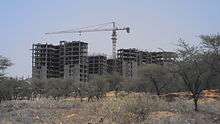
MNIT provides on-campus residential facilities to its students, research scholars, faculty members and many of its staff. Hostel rooms are wired for internet, for which students pay a compulsory charge included in the hostel fees. Most of the rooms in the hostels are designed to accommodate one student which are available after first year, and there are hostels designed for triple bedding which are leased to students of first year. Some hostels have Wi-fi networks. There are twelve hostels in all, and each hostel is provided with a common room equipped with a television, table tennis board and newspaper reading section. Students residing in hostels are issued an advisory code of conduct and ragging or harassing other students, juniors is strictly forbidden.
People
Students
MNIT enrolls 710 undergraduates, 500 post graduate and 500 doctoral students every year.[11][43] Ratio of male to female students is seven to one.[44] 50% of students are from Rajasthan, due to home state quota[45] followed by Telangana and Andhra Pradesh, Maharashtra, Gujarat, Haryana, Uttar Pradesh, Bihar, North East and other states in the same order. Students from abroad are from Saudi Arabia, United Arab Emirates, Yemen, Bangladesh, Nepal, Uganda, Sri Lanka and other middle-eastern countries.
Alumni
Alumni-institute interaction is developed and maintained through the Alumni Network and Alumni chapters across world under directions of MNIT Jaipur Alumni Association (MNITJAA). It also helps in conducting the annual alumni meets. Alumni from MNIT contribute to the society in various fields like Academics, Science and Engineering, Public Service, Corporate Service, Entertainment, Defence, Arts & Design, etc.
Notable alumni
- Thomas Abraham, president of GOPIO[46]
- Avinash Kumar Agarwal, mechanical engineer, Shanti Swarup Bhatnagar laureate[47]
- Nikhil Gupta, researcher and professor based in Brooklyn, New York[48]
- Ashok M. Raichur, nanotechnologist, N-Bios laureate[49]
- Anurag Srivastava, Spokesperson,MEA,Govt. Of India
- Shivangi, Indian Navy First Woman Pilot[50]
- Shri Heera Lal Samariya, Secretary, Ministry of Labour and Employment, Government of India.
- Rahul Khandelwal SPC at Oracle
See also
| Wikimedia Commons has media related to MNIT Jaipur. |
- National Institutes of Technology
- Indian Institutes of Technology
- Ministry of Human Resource Development
- List of Institutes of National Importance
References
- "About". MNIT. Retrieved 28 December 2015.
- "THE NATIONAL INSTITUTES OF TECHNOLOGY (AMENDMENT) ACT, 2012" (PDF). Mnnit.ac.in. Retrieved 24 July 2015.
- "Malaviya National Institute of Technology, Jaipur". Minglebox. Retrieved 23 July 2015.
- "First Statutes under the national Institutes of Technology Act, 2007" (PDF). Nitc.ac.in. Retrieved 24 July 2015.
- "Renewable energy Activity Report and Roadmap" (PDF). Mnre.gov. Retrieved 24 July 2015.
- Archived 17 July 2013 at the Wayback Machine
- "QIP Major & Minor Centre". Cepqip.iitd.ac.in. Archived from the original on 7 July 2015. Retrieved 23 July 2015.
- "Message from Director on Closing of Golden Jubilee Year Celebrations". mnit.ac.in. mnit.ac.in. Retrieved 18 May 2016.
- "Scholarships/Awards to UG students". mnit.ac.in. mnit.ac.in. Retrieved 18 May 2016.
- "List of Participating Institutes" (PDF). Csab.nic.in. Retrieved 24 July 2015.
- "Seat Matrix for UG Programmes under DASA-2015" (PDF). Dasanit.org. Archived from the original (PDF) on 22 June 2015. Retrieved 24 July 2015.
- "About the Tests – SAT Subject Test". Sat.collegeboard.org. Retrieved 23 July 2015.
- "CCMT Online Counseling – List of Participating Institutes". Ccmt.in. Retrieved 23 July 2015.
- "IIT GATE 2015". Gate.iitk.ac.in. 3 May 2013. Retrieved 23 July 2015.
- "National Institutional Ranking Framework 2020 (Engineering)". National Institutional Ranking Framework. Ministry of Education. 11 June 2020.
- "8 foreign universities that MNIT has partnerships with". Pickacollege.digit.in. Retrieved 23 July 2015.
- "News & Broadcast – World Bank Provides US$1.05 billion to Improve Education in India". Web.worldbank.org. 18 March 2010. Retrieved 23 July 2015.
- "Malaviya National Institute of Technology". Mnit.ac.in. Retrieved 23 July 2015.
- "Bhagavad Gita- Chapter 2 (Part-4) Saankhya Yogah- Yoga of Knowledge::Bhagavad Gita". Esamskriti.com. Retrieved 23 July 2015.
- "Indian Institute of Information Technology Kota". Retrieved 16 June 2016.
- "ICICI Bank – JAIPUR M.N.I.T Branch Details". Banklocations.in. Retrieved 23 July 2015.
- "IFSC Code of STATE BANK OF INDIA (SBI) – M N I T CAMPUS JAIPUR Branch, JAIPUR. Contact Phone Number, Address". Banksifsccode.com. Retrieved 23 July 2015.
- Archived 7 February 2015 at the Wayback Machine
- Archived 23 July 2015 at the Wayback Machine
- Archived 7 April 2014 at the Wayback Machine
- "About-Library". Online.mnit.ac.in. Retrieved 23 July 2015.
- "Malaviya National Institute of Technology Online catalog". Mnit-koha.informindia.co.in. Retrieved 23 July 2015.
- "Director's Report 2013-2014" (PDF). Delnet.nic.in. Retrieved 24 July 2015.
- Archived 23 July 2015 at the Wayback Machine
- "Asia's Largest Lecture Theatre Complex at MNIT". Rajasthan Patrika. Retrieved 23 February 2017.
- "Armaan Malik to perform in Jaipur at MNIT fest". The Times of India. Retrieved 21 March 2017.
- "NBA, SONY SIX AND JABONG.COM PARTNERING TO EXPAND NBA JAM TO 16 CITIES IN INDIA IN PROGRAM's SECOND YEAR". NBA.com. 10 September 2014. Archived from the original on 5 September 2015. Retrieved 23 July 2015.
- "Malaviya National Institute of Technology, Jaipur, Events in Jaipur | What's Hot". Timescity.com. Retrieved 23 July 2015.
- http://www.mnit.ac.in/sw/hostel/index.php
- "BLITZSCHLAG 14 | National Annual Technical Festival-Malaviya National Institute of Technology MNIT Jaipur-Jaipur-Rajasthan". Festpav.com. Retrieved 23 July 2015.
- "Creative Arts and Cultural Societies, MNIT Jaipur". mnit.ac.in. Retrieved 21 June 2017.
- "Archived copy". Archived from the original on 2 October 2016. Retrieved 7 June 2016.CS1 maint: archived copy as title (link)
- "Student Mentorship Program, MNIT Jaipur". Smp.mnit.ac.in. Archived from the original on 23 July 2015. Retrieved 23 July 2015.
- "Student Mentorship Program, MNIT Jaipur". Smp.mnit.ac.in. 16 April 2015. Archived from the original on 23 July 2015. Retrieved 23 July 2015.
- "Student Mentorship Program, MNIT Jaipur". Smp.mnit.ac.in. Archived from the original on 23 July 2015. Retrieved 23 July 2015.
- "Codvaids, MNIT Jaipur". mnit.ac.in. Retrieved 6 September 2015.
- "Zine, MNIT Jaipur". zine.co.in. Retrieved 28 December 2015.
- "Indian Institutes of technology and Indian School of Mines" (PDF). Jeeadv.iitb.ac.in. Archived from the original (PDF) on 5 July 2015. Retrieved 24 July 2015.
- "MNIT – Malaviya National Institute of Technology Jaipur | NIT Reviews". Stupidsid.com. Archived from the original on 27 July 2015. Retrieved 23 July 2015.
- "JEE Main 2014: Reservations, Quotas & Categories in Detail". Engineering.careers360.com. 23 December 2014. Retrieved 23 July 2015.
- "Dr. Thomas Abraham". LinkedIn. Retrieved 23 July 2015.
- "Education". IIT Kanpur. 2017.
- "Nikhil Gupta". NYU Tandon School of Engineering. 20 January 2018. Retrieved 20 January 2018.
- "Faculty profile". materials.iisc.ernet.in. 20 January 2018. Retrieved 20 January 2018.
- https://edition.cnn.com/2019/12/02/asia/indian-navy-first-woman-pilot-intk-hnk-scli/index.html. Missing or empty
|title=(help)